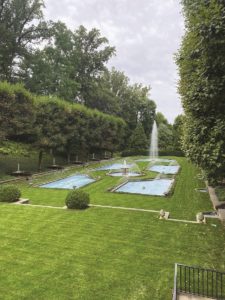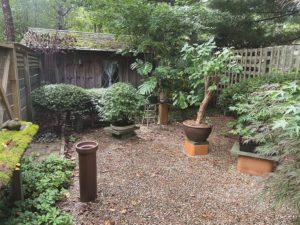On a recent trip to Philadelphia to visit friends, I had an opportunity to sit and think about space. My friends’ house is in a tightly packed neighborhood with narrow roads and slim houses. The backs of these houses and apartment buildings share a narrow alley. Each building has a walled-in garden, a private space that extends from the back of the building to the alley. I sat on the second-floor balcony, overlooking these spaces with my coffee and a notebook, thinking about what creates space and what it means to us.

Each of these little courtyard gardens is its own world, defined by its edges and the things within it. In one, a man and his neighbor were working together on a project — replacing deck boards, running back and forth from one garden to another for tools and supplies, sharing in a creative pursuit that shaped the little garden. In another, a woman filled bird feeders, pruned roses, and watered her flower-laden hibiscus. Only 10 feet away, invisible to her, the men pried boards and sweated. In the garden just below my balcony, weeds grew, butterflies drifted in the still sunlight, and a cat walked slow and fluid along the wall’s narrow top.
I’ve always been attracted to small garden spaces. There is something about an enclosure that puts the mind at ease. Within it, we can feel safe and comfortable, contained, and intimate. Not only that, a well defined space orients us. The way it is shaped — its dimensions and limits — conveys both use and feeling.
Picture in your mind a hallway, long and narrow. Its shape suggests movement. Now imagine a living room, balanced in its dimensions. It communicates stillness — a place to gather. The two spaces are like river and pond. A river is narrow and fast moving. The pond, broad in its dimension, is where water collects, slows, and stills.

A garden is often thought of as a collection of plants. A pleasing assemblage of flowers, trees, and shrubs. But a garden is not only that. The word is rooted in the concept of space, from Proto-Indo-European “to grasp or enclose.” A garden is not just something to look at, it is something to be in.
Sitting on that balcony, I remembered a landscape design professor who wore purple socks every day. “What am I doing in here?” he would scream at the class. “What does this space mean? Why is it here?” He would yell until the color of his face matched his socks. Now I know these are all the right questions to ask when creating a garden. Space is the first and strongest way to communicate a garden’s intention and feeling. It is the single most important consideration in designing a garden.
Walls, fences, hedges, planted borders, screens, and landforms are some of the ways we can create garden spaces. The materials we use and their heights will influence how we will feel within the space. The textures and colors of these elements also affect our experience. An eight-foot concrete wall and a two-foot boxwood hedge both define an edge, but we feel very different within the bounds of each.

Walls are solid, but they also offer opportunity for decoration. Hedges are living walls that can grow and change in height and depth. Fences draw narrow lines. They get a bad rap, but like healthy personal boundaries, they can be seen as something intended not for keeping things out, but for creating comfort within. Landforms like berms and elevation changes can define space in a very simple, natural way. All serve to create something within as they leave openness behind.
Think of your exterior spaces just as you might the interior of your house, where each room has a purpose and a feeling to it. One may be your favorite. Ask yourself why. Our existence is in many ways a spatial experience. Take the opportunity to engage in a dance between the mind, the material world, and the space between.



